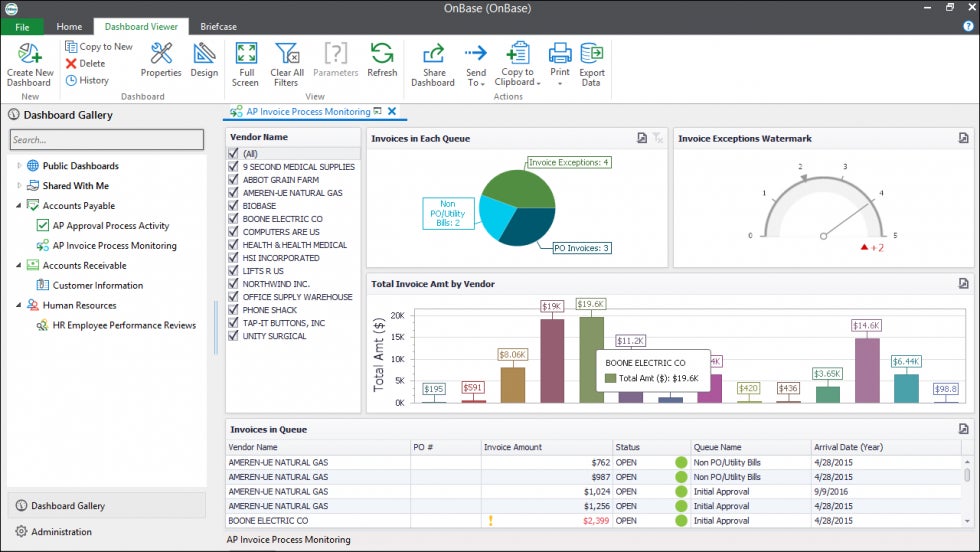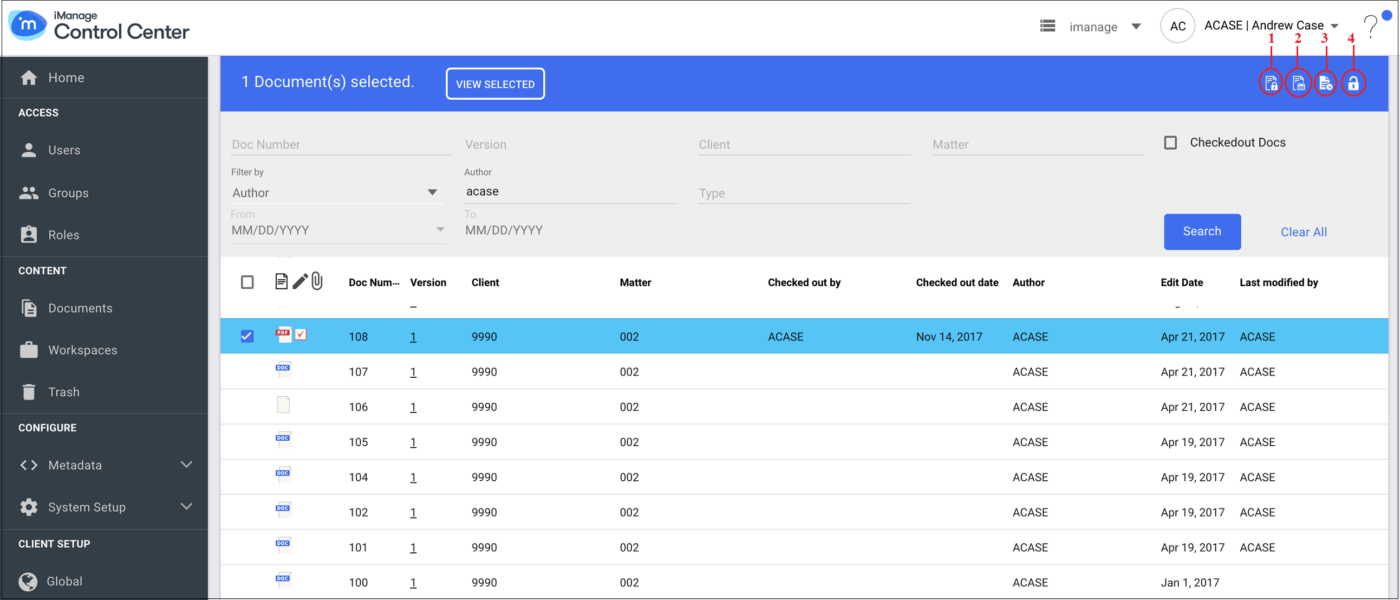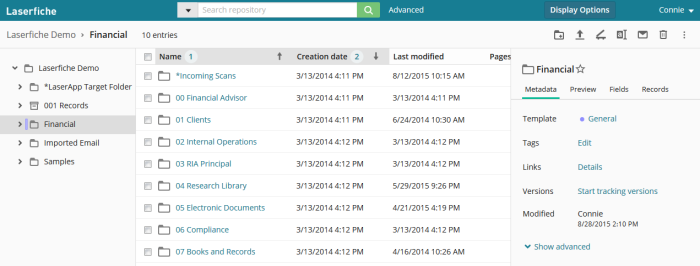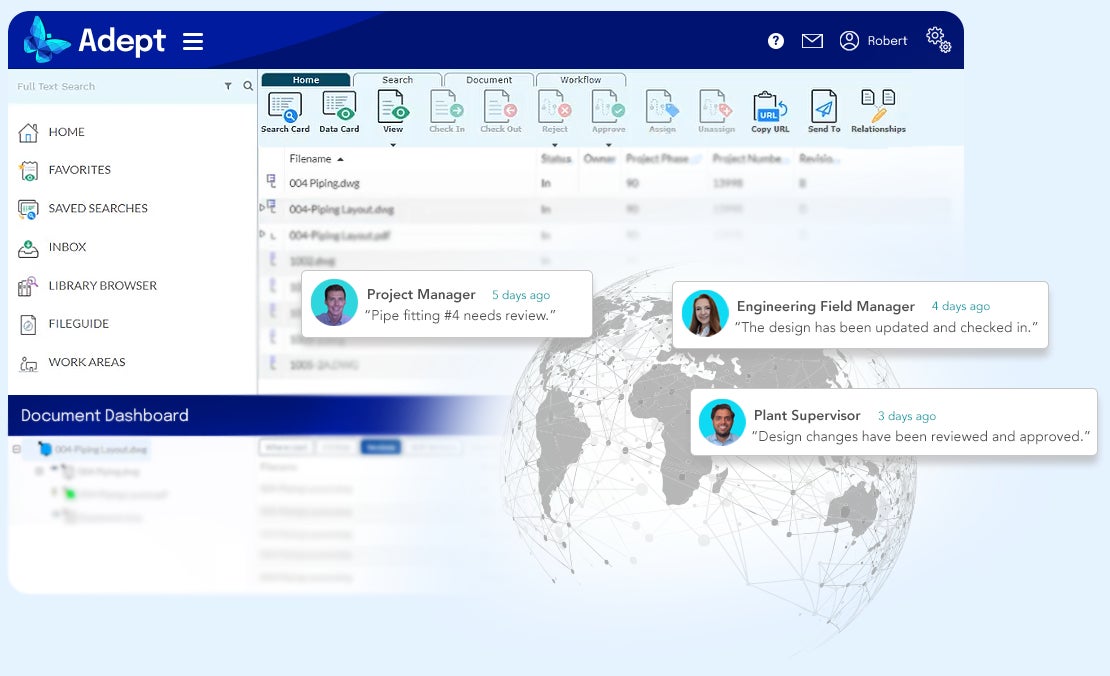
As companies continue to digitally transform, they increasingly turn to enterprise content management systems to help manage high volumes of information. In fact, the global enterprise content management market is expected to grow to $37.7 billion by 2026. Enterprise content management helps businesses manage information, such as records, images, and documents, under one roof.
Table of Contents
We’ve compiled our top enterprise content management systems based on key features, such as search capability, AI functionality, analytics, and more.
Hyland’s content management platforms help manage, organize, and distribute content effectively across an organization. The features of the suite include common features, such as advanced search and process automation but also less common features, such as case management and customer communications management. Hyland offers two content management solutions: OnBase and Perceptive Content.
Hyland’s OnBase solution is a secure, central content hub designed for software development environments. It’s built on a database, code base, and content repository so customers can build and deploy applications at scale. Document capture, data extraction, document management, system performance analytics, and more are available with this product.
Hyland’s Perceptive Content platform is geared toward content production and lifecycle management. It features interactive forms, widgets, and portals to enhance the end-user experience. Like OnBase, Perceptive Content also captures and extracts information from a variety of formats but manages multiple types of content across their lifecycle.
For instance, the Perceptive Interact tool assists in email lifecycle management by archiving and categorizing email information in a way that’s easily searchable and purges old email data. Perceptive Content’s email management feature integrates with Outlook, but if your company uses the Google Workspace, this functionality might not be available.
While OnBase focuses on back-end content management, Perceptive Content assists with front-end, externally facing content.
Best for: Enterprises that want to promote optimal end-user interaction with content.
iManage offers a comprehensive platform to help organizations manage knowledge to achieve business outcomes. As part of that platform, email management and document management leverages company knowledge into actionable insights.  iManage is a single source of truth that increases overall productivity by uniting information originating from documents and emails to break down organizational silos. At the same time, it organizes the information by client, project, etc.
iManage is a single source of truth that increases overall productivity by uniting information originating from documents and emails to break down organizational silos. At the same time, it organizes the information by client, project, etc.
iManage’s document management feature is a shared, self-service network drive that empowers end users to easily find the information they need when they need it. For example, it allows users to securely connect from any device, even work offline, and it automatically syncs users’ changes to files.
Also read: Why Data Democratization is Better Than Busting Down Silos
To help employees work smarter, not harder, iManage’s document management tool enables users to rename files in bulk, upload files to third-party apps, and more. The document management tool is designed to be quickly implemented with no training for end users, and current customers indeed confirm in their reviews that this is the case.
Designed to work well with Microsoft 365, iManage may not be the best fit for your organization if you use Google Workspace.
Best for: companies of any size looking to securely streamline email and document management.
Laserfiche’s content management solution includes document management, process automation, analytics, security, and flexible hosting–whether cloud-based or on-premise. The platform’s standout feature is its artificial intelligence (AI) functionality.
For example, Laserfiche’s AI-powered analytics estimates how long tasks will take and which tasks are likely to finish past deadlines. This allows project managers to proactively address workflow issues and set up employees for success.  Laserfiche’s data capture also runs on AI by automatically extracting, sorting, and naming data from documents, reducing the time it takes to populate and save a file and make it easily searchable.
Laserfiche’s data capture also runs on AI by automatically extracting, sorting, and naming data from documents, reducing the time it takes to populate and save a file and make it easily searchable.
Best for: mid-sized companies or enterprises that seek sophisticated AI technology in their enterprise content management system.
Zoho Docs is a comprehensive solution set up for creating, storing, sharing, and collaborating on a variety of white-labeled file formats (160+ types), all online. Zoho Docs’s primary specializations are in document management and collaboration.
Zoho Docs enables users to create a variety of documents and directly export them to the website, if desired, using its Writer tool. It’s also easy to add graphics that depict data with Zoho Docs’s Sheet tool. To share information with stakeholders, the Zoho Show tool facilitates presentations that are easy to design and shareable.
Many functionalities overlap with other major collaborative tools, such as Google Docs; however, Zoho Docs offers more nuance in its user controls. For example, document owners can mark a file as final.
Document owners are also privy to statistics on how many times a file was opened and by whom. This helps project leaders track each user’s interaction with the document to verify equitable workloads among team members. Zoho Docs also allows for controlled access of files to external audiences by providing password-protected access to authorized parties.
Best for: enterprises that desire varied levels of access control to company-owned files.
Synergis Adept is a document management platform that harmonizes business processes and documents across the organization’s workforce. 
Synergis Adept features a suite of computer-aided design (CAD) tools for complex design projects that ensures designers and engineers are working with the most current project version. One of its core document management capabilities is the data card that displays a file’s metadata that provides the most pertinent information to each member of a project team.
Files are easy to find and retrieve later on with Synergis Adept’s robust search functions. Users can find files based on metadata searches, Boolean search terms, or recently used files.
The ability to create document relationships is another way that Synergis Adept makes it easy for users to find information they seek. For example, drawings and emails are linkable to specific work orders, and CAD drawings are linkable to 3D models, including AutoCAD, MicroStation, SolidWorks, and Inventor.
Synergis Adept affords administrators control over document relationships by creating hierarchies among them. This makes it easy to see how smaller tasks roll up into larger ones.
Though Synergis Adept integrates with many popular work tools, users report issues such as lagging load time.
Best for: Mid-sized engineering, design, manufacturing companies that want to synchronize and organize complex design tools within document management.
Given the varied capabilities across vendors, we’ll break down what each feature is used for and which vendors offer it.
Advanced search is useful for quickly sifting through vast amounts of information to find what you need. The best search tools for enterprises will support sophisticated queries and return results in a variety of file formats that are contextualized to user intent and role.
If search ranks highly on a feature you desire in an enterprise content management system, check out Hyland, iManage, Laserfiche, and Synergis Adept.
AI makes the difference between mere information gathering and leveraging that information to help your business run more effectively. It helps, for example, with automatic purges of old information or extracting information from a document and saving it in the proper place.
Hyland, iManage, and Laserfiche incorporate AI for smarter content management.
Analytics in an enterprise content management system helps administrators, project managers, and other parties identify information bottlenecks and workflow disruptions as well as manage user behavior, data storage, and more.
Hyland, Laserfiche, and Zoho Docs all have analytics and reporting capabilities.
Businesses of any size proliferate a large volume of internal and external documents that necessitate proper management. All vendors here provide document management.
However, Hyland and Laserfiche help enterprises align with compliance standards by generating new documents based on industry conventions or templates. Laserfiche also uses automation for organization, saving users time from manually organizing folders, sub-folders, etc.
Zoho Docs is similar to the Google Workspace but has analytics and reporting capabilities that provide insight into the amount, composition, and use of documents and information.
Synergis Adept’s document management approach is suitable for work environments that incorporate design files generated from CAD tools.
For companies that rely on email communication as a way to exchange information, make sure that valuable information in emails is not only secure but also doesn’t fall through the cracks. Enterprise management systems like Hyland, iManage, Laserfiche, and Zoho Docs extract, link, save, and organize files that are exchanged via email.
Your company may want autonomy in choosing cloud-based, on-premise, or hybrid content management solutions. A cloud-based platform offloads data maintenance to a third party to free up your company’s own resources.
An on-premise solution gives you more control over the system and the information, more importantly over its security. If your company is in the healthcare or finance industries, you’ll want a solution that at least gives the option of on-premise hosting.
Hyland, iManage, Laserfiche, and Synergis Adept all offer flexible hosting.
If your company is in a highly regulated industry and is subject to routine audits, you’ll want record management as a feature in the enterprise content management platform of choice. Record management helps your organization effectively manage the information lifecycle—from creation to purge—in a way that is compliant to the industry you work in.
Hyland and Laserfiche offer record management as part of their solutions.
Keeping track of documents where multiple people collaborate both on- and offline creates potential confusion about which document is the most current.
iManage, Zoho Docs, and Synergis Adept all offer version control.
To choose the right vendor for your unique business needs, order the features by importance and identify the vendor that satisfies at least your top three. For a robust solution that has a lot of capability, Hyland and Laserfiche are good places to start.
Read next: Top Business Process Management Tools for 2022
CIO Insight offers thought leadership and best practices in the IT security and management industry while providing expert recommendations on software solutions for IT leaders. It is the trusted resource for security professionals who need to maintain regulatory compliance for their teams and organizations. CIO Insight is an ideal website for IT decision makers, systems integrators and administrators, and IT managers to stay informed about emerging technologies, software developments and trends in the IT security and management industry.
Advertise with TechnologyAdvice on CIO Insight and our other IT-focused platforms.
Property of TechnologyAdvice.
© 2022 TechnologyAdvice. All Rights Reserved
Advertiser Disclosure: Some of the products that appear on this site are from companies from which TechnologyAdvice receives compensation. This compensation may impact how and where products appear on this site including, for example, the order in which they appear. TechnologyAdvice does not include all companies or all types of products available in the marketplace.




